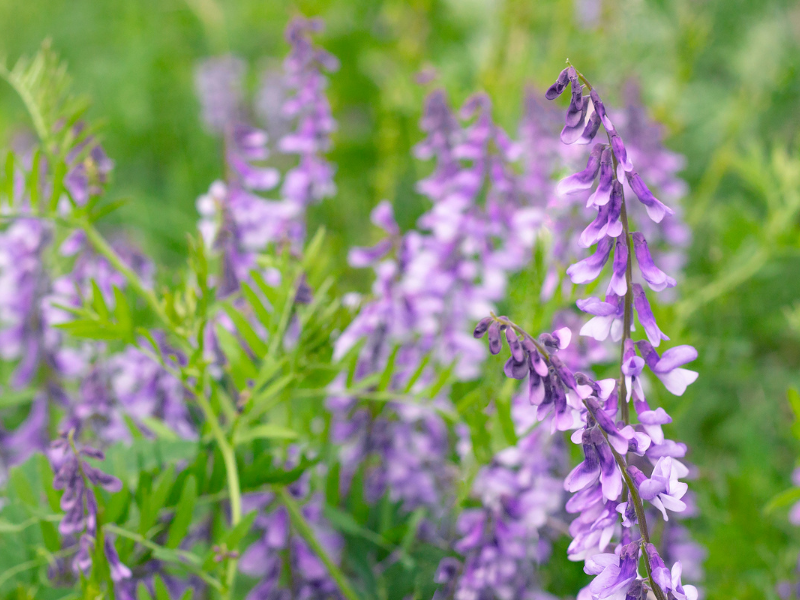Goat’s Rue and breastfeeding go hand-in-hand for many moms looking to boost their milk supply naturally. This gentle herb acts as a galactagogue—meaning it helps stimulate your body to produce more breast milk.
IMPORTANT! While Goat’s Rue can be a powerful support for low milk supply, it’s important to understand when to use it. During the first 4 to 6 weeks, your body is still regulating supply based on your baby’s needs and nursing frequency. This period is crucial for establishing a natural supply-and-demand rhythm. Introducing galactagogues like Goat’s Rue too early—before your body has a chance to regulate—may interfere with this process or lead to oversupply, which can cause issues like engorgement, clogged ducts, or mastitis.
What Is Goat’s Rue?
Goat’s Rue (Galega officinalis) is a beautiful plant native to the Middle East.
It is known for its galactagogue (increasing milk supply) properties, as shown in its scientific name (Gale = milk, ega = to bring on).

What Is Goat’s Rue Used For?
Boost Milk Production
Goat’s Rue is best known for helping support breast milk production, especially for moms who need an extra boost. It works as a natural galactagogue, which means it encourages milk flow and can help your body produce more milk faster. Many breastfeeding parents use Goat’s Rue to help with letdown and keep their supply strong during nursing or pumping.
Goat’s Rue Breast Tissue Growth
Goat’s Rue isn’t known for cosmetic breast enlargement, but it may support the development of mammary gland tissue. That’s the milk-making part of the breast, not the fatty tissue that affects cup size. So while some women do feel fuller after taking it, that’s usually because they’re making more milk — not because the herb changed their natural breast size.
Where Goat’s Rue does shine is in situations like:
- Very little breast growth during pregnancy
- Inducing lactation for adoption or surrogacy
- Suspected insufficient glandular tissue (IGT)
- A history of breast surgery that may have affected milk-making areas
In these cases, supporting mammary tissue can make a meaningful difference in milk production, which is why people often associate goat’s rue with breast growth, even though it’s not a true enlargement supplement.
So, if you’re hoping for a boost in actual cup size, this isn’t the herb for that. But if you’re curious whether Goat’s Rue might help your body build or activate more milk-making tissue, that’s where the real potential lies.
Other Traditional Uses
- Beyond breastfeeding, Goat’s Rue has a long history in herbal medicine. It’s been used to lower blood sugar levels and improve insulin sensitivity, especially in people with diabetes.
- It also acts as a mild diuretic and supports liver health. Some herbalists use it for digestion, blood purification, and even to help the body expel intestinal worms.
- Goat’s Rue also has antibacterial and anti-obesity properties, and it’s known as a diaphoretic—meaning it can help your body release sweat during illness.
While it has many uses, it’s always a good idea to talk with your healthcare provider or lactation consultant before starting Goat’s Rue—especially if you have health conditions or take medications.
Ways to Use Goat’s Rue When Breastfeeding
You can take Goat’s Rue in a few different ways—whatever feels easiest and most comfortable for you.

Goat’s Rue Tea
Use one teaspoon of dried leaves per cup of water. Let it steep for about 10 minutes. You can drink a cup up to three times a day. Want to give your supply a little extra support? Try adding other milk-boosting herbs like alfalfa, fennel, or fenugreek.
You’ll also find Goat’s Rue in ready-made teas and blends made just for breastfeeding moms. These often include other helpful herbs, too.
Goat’s Rue Capsules
A quick and easy choice if tea isn’t your thing. The typical dose is one capsule, taken three to four times a day. You can find them online (like on Amazon), but be sure to choose a brand that’s reputable and safe. Always check the label for specific directions, or talk with your healthcare provider if you’re unsure.

Goat’s Rue Tincture
This is a more concentrated form of the herb. Most tinctures are made with alcohol, glycerin, apple cider vinegar, or honey. Alcohol-based tinctures tend to be the most effective. Don’t worry—the amount of alcohol is tiny and safe for nursing. When it comes to Goat’s Rue and breastfeeding, always check in with your doctor or lactation consultant before taking it—especially if you have health conditions or take medication.
DIY Goat’s Rue Tincture
You can make your own blend right at home using a few simple ingredients.
What you’ll need
- Goat’s Rue
- Red Raspberry Leaf
- Blessed Thistle
- Fenugreek
- Marshmallow Root
- Fennel (just a little!)
- Vodka (to extract the herbal properties)
How to make it:
Start by adding half a cup of each dried herb into a clean glass jar. Use just ¼ cup of fennel, since a little goes a long way. Add a splash of water—just enough to moisten the herbs.
Next, pour in vodka using a 1:1 ratio—so your jar ends up being half herbs, half alcohol. This helps draw out all the plant’s helpful properties.
Give the jar a good shake, then store it in a cool, dry place. Let it sit for at least 2 weeks (but up to 6 weeks is even better). Shake the jar every few days to keep things moving.
When it’s ready, strain out the herbs and pour the liquid into dropper bottles for easy use.
How to take it:
Take about half a teaspoon—or 20 to 40 drops—of Goat’s Rue tincture, two to three times a day. You can mix it into a little water or juice, or take it straight under your tongue if you prefer. Whatever’s easiest for you!
What Moms Are Saying About Goat’s Rue & Breastfeeding
- I have used Goat’s Rue supplements to help battle my low milk supply after a long battle with mastitis two weeks after birth. I took the maximum dose for at least two weeks before expecting any results. My breasts became so engorged that I even gained new stretch marks!
- I used Fenugreek and Goat’s Rue together. These two herbs were my miracle herbs. My herbalist said that Goat’s Rue is excellent for women with tubular breasts.
- Goats Rue is excellent. It was given to me by a friend who also used it. I pumped exclusively for 16 months and managed to breastfeed my baby until age two. I’m told that it is used to help adoptive moms who want to breastfeed. You should give it a try.
- I had a great experience with Goat’s Rue! I tried everything (beer, oatmeal, alfalfa, and nursing/wearing baby constantly) but without success. Goats Rue was the only thing that helped with my low milk supply.
- When my baby was four months old, I decided to try the Goat’s Rue capsules, which made a huge difference. After the first ten days, my milk supply went up dramatically, and I could pump a lot more than before. I’ve now reduced my dose to only one capsule per day. It seems like the initial dosing was just the boost I needed for my low milk supply, and it’s just sort of stayed there. I responded very positively to it.
Warnings
- Don’t use the fresh plant—it’s considered toxic. Always stick with the dried version or products made from it, like teas, tinctures, or capsules.
- If you have diabetes or low blood sugar (hypoglycemia), talk to your doctor before using Goat’s Rue. This herb can lower blood sugar levels and may affect your medication.
- If you’re allergic to peanuts, soy, alfalfa, or fenugreek, it’s best to be cautious. Goat’s Rue belongs to the same plant family, so there’s a chance of a reaction.
- Avoid Goat’s Rue if you have an oversupply of breast milk. It could make things worse and lead to engorgement, plugged ducts, or even mastitis.
- Goat’s Rue may slow blood clotting, so check with your provider if you have a bleeding disorder or take blood thinners. It’s better to play it safe.
- Planning for surgery? Stop using Goat’s Rue at least two weeks before. Since it affects blood sugar levels, it might interfere with how your body handles surgery and recovery.
As always, if you are still in doubt about taking Goat’s Rue while breastfeeding, check in with your healthcare provider or lactation consultant. Your safety comes first.
Q&A
Goat’s Rue can start working within a few days, but for most people, it takes about 3 to 7 days to notice a change in milk supply. Some may need to use it for 2 weeks or longer to see full results—especially if they’re trying to build breast tissue or recover from low supply.
Everyone’s body responds differently, and the results also depend on what’s causing the low supply (e.g., hormonal issues, latch problems, previous breast surgery).
If you’re not seeing any changes after 10–14 days, it’s a good idea to check in with a lactation consultant. There may be other factors at play or a better approach for your situation.
Resources and References
- NLM – Using Goat’s Rue
- La Leche League – Online breastfeeding support


